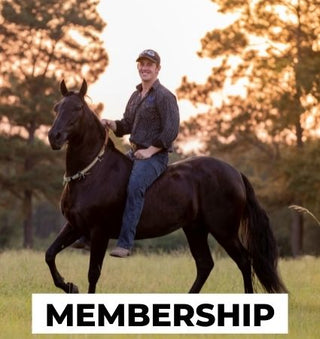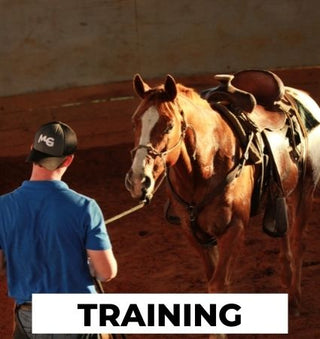Today we are talking about how to become a confident rider.
Watch The Video Here Or Continue Reading Below!
So you know our day job is pretty strenuous if you will; we go around the world riding the world’s most problematic horses. “Where do I get my confidence from,” is what I’m asked a lot of times and the big thing to remember is that success is a lot of small things done right, and being confident is a lot of small things done right on the back of a horse.
So I’m here with Rocket and he is a young colt that we’re starting, he’s a Percheron-Rocky cross and he likes to do just young colt stuff, he can crow hop here or spook here or there. What builds my confidence? First and foremost becoming a confident rider starts in your keister. I say that all the time: confidence starts in your keister. The reason is that you can have all knowledge in the world, but if your seat doesn’t make you confident, then your brain will constantly get in the way, saying, ” Hey, we’re going to die!” As long as your brain’s getting in your way, you’re going to have a hard time getting confident.
The Biggest Misunderstanding
Folks who have a really nice seat all the time will have issues staying on a young colt. Believe me, when I go to the show ring I sit up and I sit pretty, but that’s because I’m in a show ring, on a finished show horse. For the rest of the time I want to be able to grab my horn if needed. What happens whenever I’m sitting so perfect is if there’s any shift in momentum or he looks at a shadow or he sneezes: it throws me forward. Any time that my head gets in front of my hips and there’s a sudden change in momentum, it throws off my equilibrium. When it does that my brain is saying, “Hey we’re falling, and this is the response!” So that’s when you see people hug on the horn or grab on the horse’s neck.
First Thing To Become A Confident Rider
What I want to do to build my confidence is scoot forward in that saddle and take my butt and roll back on it. I’m essentially sitting in the same place. The difference is instead of sitting here with that Kim Kardashian butt lift and my cheeks hanging out behind me, instead of my butt being behind me I want to be on top of my butt. Rolling my hips under like that is really going to help me be confident on this big boy.
The other thing is the butt is the motor of the horse, the shoulders are the direction of the horse. If he spooks on a trail or spins or bolts or jumps, the shoulders will be the part moving first and the hindquarters will be the part pushing. If I’m sitting over the pivot point when he spooks at that turkey and spins to the right, my mind will stay clear, I won’t trip my equilibrium, and I’ll be able to face up.
So scoot forward in your saddle all the way till you get to the front and roll back on your hips. When I say sit back it doesn’t mean arch your back backward, it means scoot forward and roll back on your hips. Now I automatically feel more comfortable. My shoulders are getting further back and my heels are coming forward. The further from your vertical line you get the more balance you have, that’s why bronc riders ride like this. Now we don’t have to be as exaggerated as them, but if you’re a trail rider or pleasure rider or just a rider trying to become more confident, this position will work great for you.
In The Industry
If you see jumping riders they have to be more forward to get that horse’s back rounded up to go over a fence. Because of that, they’re in a vulnerable position, therefore when the horse stops they fall off. On the other end of the spectrum are cutting riders. They come in on a horse and they sit hunched down like this. They cut a cow out of the herd, they hold on to the horn here, they drop the reins, and that horse jumps left jumps right mirroring anything the cow does. The rider has no idea where they’re going but they feel confident they can ride it. So much so that they can do it bareback and bridleless because they have such a good seat.
So whenever we’re trying to become a confident rider, think about rolling your butt under and bringing your shoulders back. Now instead of being perfectly at my vertical line, now my heels are in front of my hips and my shoulders are behind my hips. The more that I can do that the more confident I’m going to feel.
Build Your Confidence In Your Horse: Control Their Head
Now the next thing, now that I’ve got confidence in my keister, it’s the horse that I’m riding. What I want to see is if I have control of his face if he wanted to do something. Whenever I start sliding my hands down the reins, before I go anywhere I notice, “hey he didn’t want to give me his face right there.” I’m just going to start flexing him to the left and right and make sure I have a steering wheel. If he’s going all over the place and not giving me what I want, I’ll go one way then I’ll go the other way, then repeat. I’ll just keep turning the steering wheel back and forth, back and forth, until it knocks the rust off.
You’re not going to become a confident rider if you don’t feel like you’re in control. Speed is not the issue guys. Pressure is not the issue. The issue is you’re lacking control. You do 70 to 80 miles per hour in your vehicle every day on the way to and from work and wherever you’re going, you don’t feel uncomfortable at all because you feel in full control. Confidence comes from a good stable seat that keeps you in a clear mind and gives you the feeling of control.
Control Is Key
Before this ride starts and before I do anything I’m just making sure I have control. If I can’t turn the steering wheel left and right without him getting fussy about it and trying to take the steering wheel away from me then I’m not really in control. Since I’m not in control I’m not going to feel confident. A lot of you don’t realize that that’s why you don’t feel confident. It’s because you’re not in real control and a lot of times there’s not common knowledge of what gets us in control of a horse. I wish somebody would just come along and say, “hey if you can’t flex your horse, don’t ride your horse.” “Hey if you can’t disengage your horse, don’t ride your horse.” “Hey if you can’t move that horse’s butt, don’t ride it.” I wouldn’t, and I ride nasty horses for a living.
If you’re doing this for your fun hobby and you have one or two horses in the back: don’t ride until you get control of the steering wheel. See now how he started giving up his head? Now I’m starting to feel in control. In control feels like confidence, now I’m feeling more confident about the situation.
Control Their Butt
Now that he gave me his face, I want to make sure I have his butt. So I slide my hand down the rein and I pull his face to his butt until his butt moves around, then I give him his face. Switch sides and I slide my right hand down, I look at his butt. Of course you can see how to do all these things in our video series: Control The Head Control The Horse, but we’re just talking about the things that make me feel confident.
All right so we got his head and we got his butt, these are the basic controls of a horse. If you don’t have their face and you don’t have their butt: you should not ride. If that horse doesn’t back up from you from the ground: you should not ride. The horse doesn’t drop his head to you from the ground: you should not ride. All of these things are telling you that the horse doesn’t respect you enough to give.
Final Thing To Help Become A Confident Rider
Once you have that, then the last thing that’s going to push you over the top to become a confident rider is now you’re going to try to set your horse off. That’s what obstacles and desensitization are for. The two ways to build situational resistance, or to make that horse uncomfortable and see if they’re trustworthy in a bind, is to scare the bejesus out of them with tarps, balls, soccer, anything you want. Scare them and see if you can control their head and their butt. Another thing is to go fast. Start at the walk, then at the trot, then at the canter, and see if you can control their head and their butt.
In Conclusion
Confidence is a lot of small things done right. It starts right here in your seat so that you feel confident and you feel stationary. You don’t feel like you’re going to fall and you’re not thrown off equilibrium. Confidence starts in your keister, that’s Number One. Number Two is can you control the horse’s head? Can you just slide the hand down the rein and bend your horse’s head around? Number Three be able to control his butt. If he can’t get his motor under him and he can’t drive then he can’t buck, run, or rear. All those things are in a straight line so if we have the ability to bend him then no matter how excited he gets if we can just slide our hand down the rein and move his butt: you’re going to feel confident.
That’s how we ride confidently! Thank you guys so much for reading how to become a confident rider, join me next week for the next topic!
Check out more free training resources HERE!









